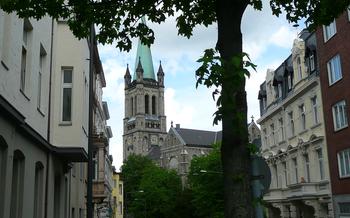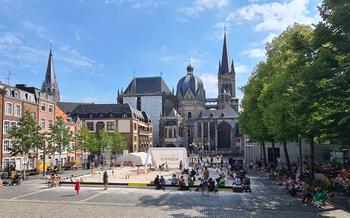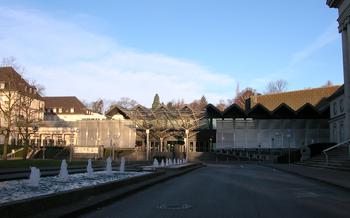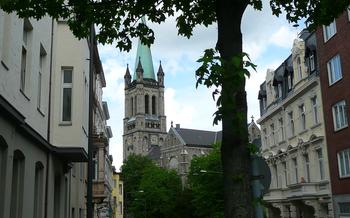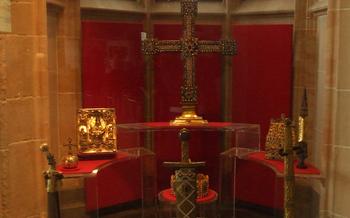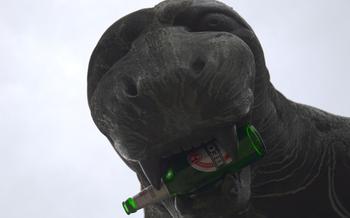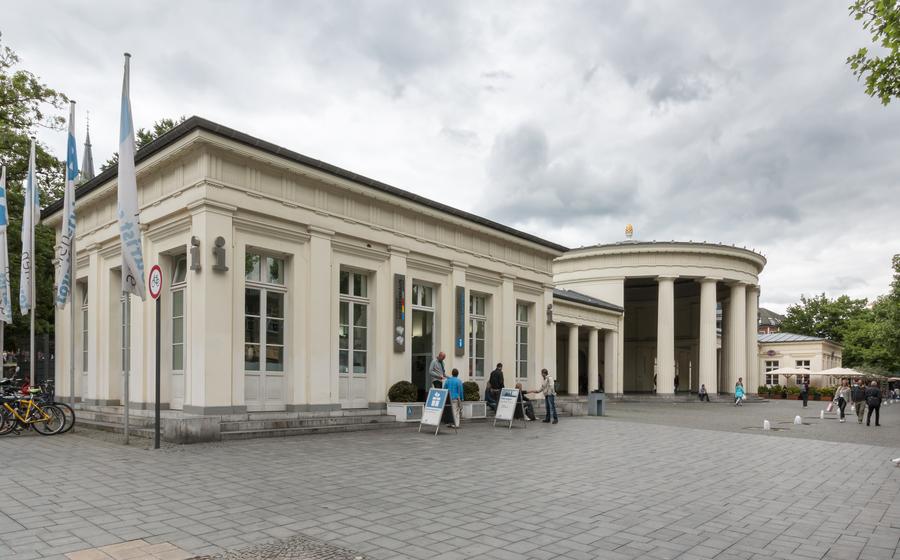
Elisenbrunnen
- Unveiling the History of the Elisenbrunnen
- Exploring the Architectural Masterpiece
- The Healing Waters of the Elisenbrunnen
- Practical Tips for Visiting the Elisenbrunnen
- The Elisenbrunnen in Contemporary Culture
- Exploring Aachen's Thermal Baths District
- The Elisenbrunnen's Architectural Legacy
- The Elisenbrunnen's Healing Legacy
- The Elisenbrunnen's Cultural Significance
- The Elisenbrunnen's Future: Challenges and Opportunities
- Hidden Gems of the Elisenbrunnen
Unveiling the History of the Elisenbrunnen
The Elisenbrunnen's history is a captivating tale interwoven with the rise and fall of empires, the patronage of powerful rulers, and the enduring belief in the healing power of thermal springs. Its story begins in Roman times when the thermal baths were first constructed, taking advantage of the naturally occurring hot springs that bubbled up from deep within the earth. These baths were not just places for bathing but also served as social and cultural hubs, where people from all walks of life could gather, relax, and socialize.
During the Carolingian era, Charlemagne, the Holy Roman Emperor, made Aachen his favorite residence and transformed the city into a cultural and intellectual center. He recognized the therapeutic value of the thermal springs and played a pivotal role in developing the spa town. Under his patronage, the thermal baths were expanded and embellished, attracting visitors from far and wide.
The Middle Ages marked a period of prosperity for Aachen, and the spa town continued to flourish. The Elisenbrunnen became a symbol of the city's wealth and prestige, drawing pilgrims and travelers seeking relief from various ailments. The thermal springs were believed to possess miraculous healing powers, and stories of miraculous cures circulated throughout Europe.
In the 19th century, the Elisenbrunnen underwent a significant transformation. The spa town was modernized, and the Elisenbrunnen was rebuilt in the Neoclassical style, giving it the grand and imposing appearance we see today. This renovation marked a new chapter in the Elisenbrunnen's history, as it became a popular destination for spa-goers and tourists alike.
Exploring the Architectural Masterpiece
The Elisenbrunnen stands as a testament to the architectural ingenuity of its time, showcasing a harmonious blend of Neoclassical grandeur and symbolic elements. The imposing façade greets visitors with a majestic colonnade of Corinthian columns, supporting an elegant entablature adorned with intricate carvings. Central to the façade is a grand pediment, featuring a sculptural tableau that pays homage to the healing powers of the thermal springs.
Stepping inside the Elisenbrunnen, visitors are awed by the grand entrance hall, a spacious and luminous atrium that sets the tone for the building's opulent interior. The highlight of the hall is the stunning rotunda, a circular chamber defined by a series of graceful Ionic columns. The ceiling of the rotunda is a masterpiece in itself, featuring intricate stuccowork and allegorical paintings that pay tribute to the healing arts.
Throughout the building, visitors are greeted by a symphony of intricate details and sculptures that add depth and character to the Elisenbrunnen's design. The walls are adorned with bas-reliefs depicting scenes from mythology and history, while the niches house elegant statues of notable figures associated with the spa town. The harmonious interplay of architectural elements, sculptures, and decorative motifs creates a visually captivating experience that leaves visitors spellbound.
Beyond the main building, the surrounding gardens offer a tranquil oasis, providing a serene escape from the bustling city. The gardens are meticulously landscaped, featuring manicured lawns, colorful flowerbeds, and towering trees that provide shade and tranquility. Visitors can stroll along the winding paths, marveling at the beauty of the natural surroundings and enjoying the soothing sounds of the flowing waters.
The Healing Waters of the Elisenbrunnen
The Elisenbrunnen's thermal springs have been revered for centuries for their remarkable healing properties. According to historical records, the waters contain a rich blend of minerals, including sodium, calcium, magnesium, and iron, which have been shown to have various therapeutic benefits.
In the past, people suffering from various ailments, including rheumatism, skin diseases, and digestive disorders, flocked to Aachen to seek relief in the healing waters. The springs were believed to have miraculous powers, and many visitors claimed to have experienced significant improvements in their health after bathing in or drinking the water.
Modern scientific studies have corroborated these historical accounts, demonstrating that the mineral-rich waters indeed possess therapeutic properties. The high concentration of dissolved solids, particularly bicarbonates and sulfates, has been found to have anti-inflammatory, pain-relieving, and detoxifying effects.
Today, the Elisenbrunnen continues to attract visitors seeking relief from a wide range of health conditions. The spa offers various treatments and wellness programs that harness the healing powers of the thermal springs, including bathing, drinking cures, and massages. Visitors can choose from a range of options tailored to their specific needs, whether it's stress reduction, pain management, or overall rejuvenation.
Practical Tips for Visiting the Elisenbrunnen
Opening Hours and Admission Fees: * The Elisenbrunnen is open to the public daily from 9 am to 6 pm. * Admission is free of charge.
Guided Tours and Self-Guided Exploration: * Guided tours of the Elisenbrunnen are available in English and German at specific times. * Visitors can also explore the building and its surroundings at their own pace. * Informative brochures and maps are provided for self-guided tours.
Dress Code and Spa Etiquette: * While there is no strict dress code for visiting the Elisenbrunnen, modest and respectful attire is recommended. * Visitors are expected to maintain silence and behave respectfully in the spa's tranquil environment. * For those seeking spa treatments, appropriate swimwear is required.
Accessibility for Visitors with Disabilities: * The Elisenbrunnen is wheelchair accessible, with ramps and elevators providing easy access to all areas of the building. * Disabled parking spaces are available nearby. * Visitors with disabilities can request assistance from the friendly staff if needed.
The Elisenbrunnen in Contemporary Culture
The Elisenbrunnen has transcended its role as a mere spa facility and has become an iconic symbol of Aachen's identity. It is deeply embedded in the city's cultural fabric and plays a significant role in local festivals and events. The Elisenbrunnen serves as a backdrop for concerts, art exhibitions, and cultural performances, transforming the space into a vibrant hub of creativity and entertainment.
Beyond its local significance, the Elisenbrunnen has also gained recognition in literature, art, and popular culture. It has been featured in novels, poems, and paintings, capturing the imagination of artists and writers alike. The Elisenbrunnen's unique architectural style and historical significance have made it a popular subject for artistic representation.
In recent years, there have been ongoing efforts to preserve and promote the Elisenbrunnen's rich heritage. The city of Aachen has undertaken extensive restoration projects to maintain the building's architectural integrity and ensure its continued use for future generations. These efforts have been complemented by cultural initiatives aimed at raising awareness of the Elisenbrunnen's historical and cultural significance.
The Elisenbrunnen stands as a testament to Aachen's rich history and cultural heritage. Its enduring legacy continues to inspire and captivate visitors, solidifying its position as one of the most iconic landmarks in Germany.
Exploring Aachen's Thermal Baths District
Aachen's rich thermal bath culture extends beyond the Elisenbrunnen. The city boasts a network of historic thermal baths, each with its unique charm and therapeutic offerings. Embark on a journey of relaxation and rejuvenation as you explore these hidden gems.
The Carolus Thermen, located in the heart of the city, is a modern spa complex that combines traditional thermal bathing with state-of-the-art wellness facilities. Indulge in a variety of thermal pools, saunas, and steam baths, while enjoying panoramic views of the city.
For a more intimate experience, visit the Thermalbad Quellenhof, a charming bathhouse nestled in a tranquil park. Soak in the soothing thermal waters, surrounded by elegant architecture and lush greenery.
Discover the historic Thermalbad Bad Aachen, the oldest thermal bath in the city, dating back to the Roman era. Experience the healing power of the thermal springs in an authentic setting, reminiscent of Aachen's rich bathing traditions.
The Elisenbrunnen plays a pivotal role in the revitalization of Aachen's thermal baths district. Its iconic status and therapeutic offerings have attracted visitors from around the world, contributing to the district's growing popularity as a spa destination.
To create a comprehensive spa itinerary, start your day with a visit to the Elisenbrunnen, experiencing its healing waters and architectural beauty. Continue your journey at the Carolus Thermen, enjoying its modern amenities and panoramic views. Conclude your spa day with a relaxing soak at the Thermalbad Quellenhof or the Thermalbad Bad Aachen, immersing yourself in their tranquil ambiance and historic charm.
The Elisenbrunnen's Architectural Legacy
The Elisenbrunnen's architectural significance extends beyond its own walls, as it served as an inspiration for numerous other spa buildings across Europe and beyond. Its distinctive Neoclassical style, with its symmetrical façade, grand entrance hall, and intricate detailing, became a model for many subsequent thermal bathhouses. Notable architects and designers, such as Friedrich Weinbrenner and Leo von Klenze, were influenced by the Elisenbrunnen's design when creating their own spa masterpieces. The Elisenbrunnen's legacy can be seen in spa architecture throughout Germany, including the Friedrichsbad in Baden-Baden and the Carolus Thermen in Aachen. Its influence is also evident in spa towns across Europe, such as Bath in England and Karlovy Vary in the Czech Republic. The Elisenbrunnen's enduring impact on spa architecture is a testament to its timeless beauty and functionality, making it a revered model for contemporary spa design. Architectural awards and recognition have further solidified the Elisenbrunnen's status as a landmark of architectural significance, ensuring its legacy as a source of inspiration for generations of architects and designers.
The Elisenbrunnen's Healing Legacy
The Elisenbrunnen's reputation as a healing sanctuary is deeply rooted in scientific evidence and historical accounts. Numerous studies have confirmed the therapeutic benefits of the thermal waters, attributing their efficacy to their unique mineral composition. Rich in sulfur, calcium, and magnesium, the waters have been shown to alleviate a wide range of ailments, including rheumatism, arthritis, skin conditions, and respiratory problems.
Historical records and anecdotes abound with tales of miraculous cures experienced by those who bathed in the Elisenbrunnen's waters. In the 16th century, the famous physician Paracelsus extolled the virtues of the springs, claiming that they possessed the power to heal even the most severe diseases. Over the centuries, countless visitors have sought relief from their afflictions at the Elisenbrunnen, many of whom left with renewed health and vigor.
In modern times, the Elisenbrunnen continues to be a center for medical research and innovation. Scientists are actively studying the therapeutic effects of the thermal waters, exploring their potential in treating various conditions. The Elisenbrunnen's legacy as a healing sanctuary endures, attracting individuals from around the world who seek to experience the restorative powers of its waters.
The Elisenbrunnen's Cultural Significance
The Elisenbrunnen is not only a testament to Aachen's architectural and healing heritage but also holds immense cultural significance. As a symbol of the city's rich history and culture, it has played a pivotal role in shaping Aachen's identity and heritage. The Elisenbrunnen has been a source of inspiration for artists, writers, and musicians throughout the centuries, capturing their imaginations with its beauty and mystique. The building's unique architectural features, combined with the healing properties of its thermal waters, have made it a beloved subject for creative expression.
The Elisenbrunnen's cultural significance is further underscored by its inclusion in UNESCO's World Heritage List. This prestigious recognition acknowledges the Elisenbrunnen's outstanding universal value and its importance as a cultural landmark of global significance. The Elisenbrunnen's inclusion on the World Heritage List ensures its preservation for future generations, allowing people worldwide to appreciate its architectural splendor and healing legacy.
The Elisenbrunnen's Future: Challenges and Opportunities
The Elisenbrunnen, a beacon of history and healing, faces both challenges and opportunities in the modern era. One challenge is balancing preservation with modernization. While preserving the Elisenbrunnen's architectural integrity and historical charm is vital, it must also adapt to meet the needs of contemporary visitors. Sustainable practices and energy-efficient upgrades can be implemented without compromising the building's character.
Another challenge is the impact of modern tourism. The Elisenbrunnen's popularity as a tourist attraction has led to increased foot traffic and wear and tear. Managing tourism responsibly while minimizing its environmental impact is crucial. This could involve implementing crowd management strategies, promoting off-peak visits, and educating visitors about the importance of respecting the historic site.
Opportunities for the Elisenbrunnen lie in its potential role in urban development and regeneration. The surrounding thermal baths district presents an opportunity for revitalization, with the Elisenbrunnen serving as a centerpiece. Integrating the Elisenbrunnen into broader urban planning initiatives, such as pedestrian-friendly zones and green spaces, could enhance the area's livability and attractiveness.
Additionally, innovative ideas for preserving and promoting the Elisenbrunnen's legacy can be explored. Virtual reality tours, augmented reality experiences, and interactive exhibits could enhance the visitor experience while providing a deeper understanding of the site's history and significance.
By embracing these challenges and capitalizing on the opportunities, the Elisenbrunnen can continue to be a source of healing, inspiration, and cultural heritage for generations to come.
Hidden Gems of the Elisenbrunnen
Beyond its iconic facade and grand interior, the Elisenbrunnen holds a treasure trove of hidden gems waiting to be discovered by curious explorers. One such secret is the Whispering Gallery, tucked away in a secluded corner of the building. Stand facing one of the gallery's walls and whisper a message, and your words will be carried across the room to someone standing opposite you, an acoustic phenomenon that adds a touch of magic to your visit.
Another hidden gem is the Secret Garden, a serene oasis nestled behind the Elisenbrunnen's walls. This tranquil retreat offers a peaceful escape from the hustle and bustle of the city, where visitors can relax amidst lush greenery, fragrant flowers, and the gentle sound of trickling water.
For history buffs, the Historical Archives located within the Elisenbrunnen provide a fascinating glimpse into the building's past. Here, visitors can peruse old photographs, documents, and artifacts that tell the story of the Elisenbrunnen's evolution from a Roman bathhouse to a world-renowned spa.
Finally, don't miss the Rooftop Terrace, which offers panoramic views of Aachen and the surrounding countryside. Ascend to the top of the Elisenbrunnen and take in the breathtaking vistas, capturing the city's landmarks and the rolling hills beyond.

